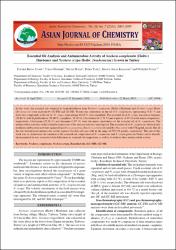Essential oil analysis and antimicrobial activity of neckera complanata (Hedw.) huebener and neckera crispa Hedw. (Neckeraceae) grown in Turkey

View/
Access
info:eu-repo/semantics/openAccessDate
2014Author
Cansu, Tayyibe BeyzaÖzdemir, Turan
Batan, Nevzat
Yaylı, Büşra
Karaoğlu, Şengül Alpay
Yaylı, Nurettin
Metadata
Show full item recordCitation
Cansu, T.B., Ozdemir, T., Batan, N., Yayli, B., Karaoglu, S.A., Yayli, N., (2014).Essential Oil Analysis and Antimicrobial Activity of Neckera complanata (Hedw.) Huebener and Neckera crispa Hedw. (Neckeraceae) Grown in Turkey.Asian Journal of Chemistry, 26(7), 2005-2008, A.https://doi.org/10.14233/ajchem.2014.15618AAbstract
In this work, the essential oils obtained by hydrodistillation from Neckera complanata (Hedw.) Huebener and Neckera crispa Hedw (Neckeraceae) were analyzed by GC-FID and GC-MS. Twenty-one compounds in the oil of N. complanata, representing 71.61 % and forty-two compounds in the oil of N. crispa, representing 82.12 %, were identified. The essential oil of N. crispa was rich in terpenes (58.68 %) with ?-phellandrene (20.00 %), camphene (10.36 %), ?-bisabolene-E (5.51 %) and ?-pinene (3.49 %) as the major components, respectively. 3-Octanone (22.26 %) and limonene (2.97 %) were the major constituents of the essential oil of N. complanata. The antimicrobial activities of the isolated essential oils of the mosses were also investigated. The essential oil of N. complanata showed only moderate antibacterial activities against Staphylococcus aureus, Enterococcus faecalis and Bacillus cereus with 576 ?g/mL (each). But all the oils showed good antimycotic activity against Candida albicans with in the range of 573-576 ?g/mL, respectively. The aim of this work was to characterize the variation in the essential oil composition of N. complanata and N. crispa grown in Turkey and to identify environmental factors associated with differences in essential oil composition as well as to evaluate their antimicrobial activity.

















